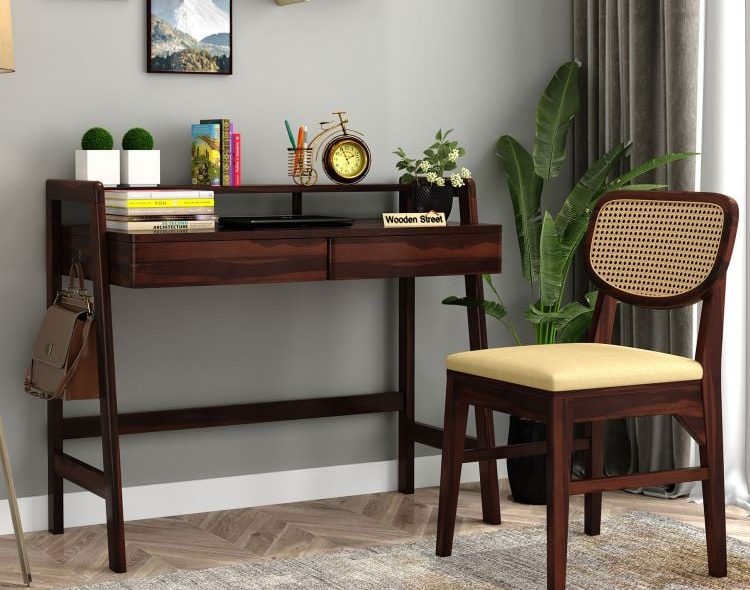A well-designed study space is crucial for productivity, focus, and comfort—whether you are a student, a remote professional, or someone who spends hours reading and writing. One of the most significant components of this setup is a study table with chair. But not just any table and chair will do. The right combination can enhance your concentration, reduce physical strain, and even boost your motivation.
When shopping for a study table and chair, it’s easy to get overwhelmed by the sheer number of options available. That’s why understanding the essential features of a high-quality set is important. Below, we break down the seven key features that define a great study table with chair—helping you make a smarter and more comfortable choice.
1. Ergonomic Design for Comfort
The most important feature to look for in a study table and chair is ergonomic design. Long hours of study or work can cause back pain, neck stiffness, and fatigue if you’re not seated properly. An ergonomically designed chair supports your spine, provides lumbar support, and keeps your body aligned.
Look for chairs with adjustable height, cushioned seating, and proper armrests. The study table should also have a comfortable height, typically around 28–30 inches for adults, to prevent hunching over or straining your eyes.
2. Adequate Storage Options
A clutter-free desk leads to a clutter-free mind. A great study table includes ample storage like drawers, shelves, and even hidden compartments. These help keep your workspace organized and ensure that everything you need is within arm’s reach.
Consider your specific needs. Do you use stationery often? Need space for notebooks, files, or gadgets? A table with customizable or modular storage can accommodate changing needs over time.
3. Durability and Quality Material
A study table with chair is an investment, so it’s important to choose one made from high-quality and durable materials. Solid wood like Sheesham or engineered wood like MDF are popular for their strength and aesthetic appeal.
Metal frames and anti-rust coatings offer extra durability. The chair should also be built to withstand daily use, with firm padding that doesn’t flatten out and smooth-rolling wheels if it’s a mobile chair.
4. Space-Saving Design
Not everyone has a dedicated study room. If you’re working with limited space, a compact and space-saving design becomes essential. Foldable tables, wall-mounted designs, or study tables with vertical shelving can maximize utility in smaller rooms.
The chair should slide in completely under the table to save floor space when not in use. Look for sets that are thoughtfully designed to balance functionality with minimal footprint.
5. Proper Lighting Support
Good lighting is critical for reducing eye strain and enhancing focus. While the table itself doesn’t provide lighting, its design should support optimal task lighting. Look for features like built-in lamp holders, power sockets, or designated space to install a desk lamp.
Surfaces in lighter shades or with matte finishes help reflect light evenly without causing glare. Some advanced study tables even come with integrated LED lights—especially useful in low-light environments.
6. Adjustability for Multiple Users
If the table and chair will be used by more than one person—such as siblings, roommates, or children growing up—adjustability becomes a critical feature. Look for a chair with height adjustment, tiltable backrest, and even a footrest if necessary.
For study tables, height-adjustable models are rare but ideal. Alternatively, choosing a standard-height table with an adjustable chair ensures adaptability across various users and activities, from writing to typing to sketching.
7. Aesthetic and Functional Appeal
Your study table and chair should match the overall aesthetic of your room while also being functional. Whether your style is minimalist, modern, rustic, or Scandinavian, there’s a study table set that complements your space.
Functional appeal includes smooth edges (especially for kids), cable management holes, sturdy leg frames, and waterproof or scratch-resistant surfaces. All these enhance the user experience without compromising on looks.
Bonus Tips for Choosing the Right Study Table with Chair
Measure your space: Always check the dimensions of the furniture and the room to avoid overcrowding.
Try before you buy: If possible, sit on the chair and test the table height before purchasing.
Read reviews: Genuine user feedback can reveal practical pros and cons not mentioned in product listings.
Think long-term: Choose a set that can grow with your needs, especially for children or evolving work-from-home setups.
Conclusion
A study table with chair is more than just furniture—it’s a productivity tool. From comfort and durability to storage and style, each feature plays a role in creating a space that supports learning, working, and thinking clearly. When you prioritize these seven essential features, you invest not only in furniture but also in your well-being and efficiency.
Whether you’re designing a dedicated study room or fitting a work nook into your bedroom, choosing the right study setup can make all the difference. Take your time, do your research, and pick a table and chair that you’ll love working at every day.
 :
https://in.pinterest.com/woodenstreet/
:
https://in.pinterest.com/woodenstreet/

